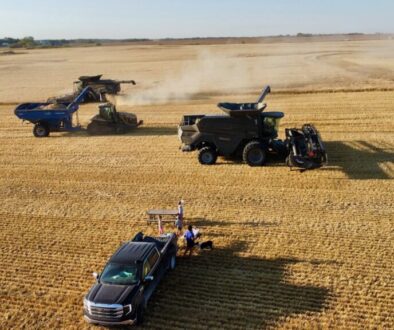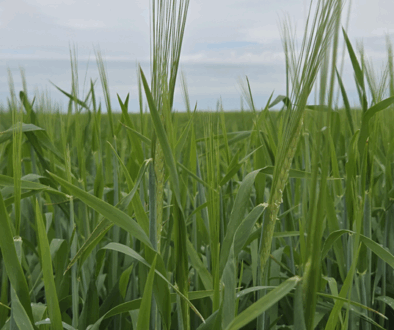This bulletin addresses the following areas for the
2022 growing season:
-
Growing malting vs.
feed barley;
-
Malting barley
variety selection for success;
-
Certified vs. farm
saved seed;
-
Desired end-user
quality characteristics in malting
barley
MALTING VS. FEED BARLEY
Producers who are planning to grow barley should
consider the following:
-
Growing a malting
barley variety enables producers to access
an additional 2-2.5 million tonne
marketplace. Canada’s malt processors
typically buy over 1 million tonnes of
malting barley annually, and in recent years
malting barley exports have topped 1 million
tonnes (in 2020-21 they reached 1.6 million
tonnes);
-
New malting barley
varieties have seen considerable
improvements in agronomics in recent years
with better yields, standability and disease
resistance. Producers who opt to grow newer
malting barley varieties will typically not
lose much in the way of yield compared with
high yielding feed varieties like CDC
Austenson (see yield data
below);
-
Malting barley
generally trades at a $0.50-1.00 per bushel
premium to feed. On a quarter section of
land, based on a 70 bushel per acre yield,
malting barley has a $5,600-$11,200
advantage over feed
barley;
-
Growing a malt
variety allows producers to further
differentiate themselves and to develop
relationships and long-term marketing
opportunities in the malting
sector;
-
Canada is one of only
a select few countries supplying malting
barley and malt to the world marketplace,
and Canada is recognized as a trusted and
reliable supplier of premium quality
product. With very tight supplies of malting
barley globally due to production problems
in 2021, producers can expect strong demand
for malting barley off the combine in the
fall of 2022.
-
By choosing a malting
barley variety, producers have access to
both malting and feed markets, mitigating
their marketing and price
risk.
WHICH MALTING BARLEY VARIETY TO
CHOOSE?
-
Canada’s barley
breeders have developed a lineup of
excellent new malting barley varieties, each
with strong agronomics and
disease resistance, that
are poised to replace older malt varieties
in the marketplace.
-
These new varieties
also have very desirable
end-use malting and brewing
characteristics, reinforcing
Canada’s position as a supplier of premium
quality barley and malt, and are
increasingly accepted by domestic and
international maltsters and brewers.
-
As seed
supply will be limited for 2022,
producers should check with local
seed suppliers
early.
-
Newer malting
varieties such as AAC Connect,
CDC Fraser and CDC Bow are
already accepted by many domestic and
international maltsters and
brewers.
-
Depending on whether
a producer is looking for higher or lower
amounts of crop residues after harvest, new
malting barley varieties vary in the amount
of straw they generate. Crop height can be a
rough indication of a variety’s straw
production.
-
Although
production challenges vary across
malting barley growing regions, the
expanding selection of excellent new
malting varieties ensures producers
can select a variety that fits their
needs.
-
While the dry growing
season limited disease pressure in 2021,
producers should pay attention to disease
resistance in their variety selection
and test the seed lot they intend to
plant in 2022 as there may
still be seed borne disease in 2021
supplies. Test seed as soon as possible so
options are still available if new seed
supply is required.
-
Producers should
check with their local seed dealers as to
which malting barley varieties perform well
in their area, and discuss contracting
options with their local malting barley
buyer. Provincial seed guides are also an
excellent source of regional variety
performance data.
Improved Yields & Lodging
Resistance
-
New Canadian malting
barley varieties have significant yield
improvements over their predecessors. The
provincial seed guides indicate yields among
the new varieties are comparable to the most
widely grown feed barley variety, CDC
Austenson.
Note that each provincial
seed guide has its own system of comparing
yields, please see the indicator at the top of
each table.
|
|
Lodging
– In many environments, new Canadian malting barley varieties
have improved standability with good to very good
lodging resistance compared with older
varieties. In some cases, this may enable producers to
boost fertilization rates without risk of lodging.
Note: In areas where environmental conditions, combined
with agronomic management (high rates of nitrogen
fertilizer), are favorable for lodging, the new cultivars
may still lodge.
CERTIFIED VS FARM GROWN SEED
-
The
drought conditions in 2021 affected both commercial and
certified seed crops. Certified seed availability will
vary by geography so producers should speak to their
local seed suppliers early. Seed companies
typically have a seed locator link on their website, or
producers can consult provincial seed
guides.
-
While
the CMBTC recommends producers use certified seed to
help guarantee quality and purity, producers can also
save and reuse their own farm-grown seed. Regardless of
the seed source, it is important to know seed
germination, thousand kernel weight and disease analysis
from an accredited lab to ensure seed is not diseased
and calculate appropriate seeding
rates.
-
Most
seed sellers will test for thousand kernel weight and
disease, so be sure to ask. It is also important to note
that it is illegal for producers to sell or trade
varieties with Plant
Breeders Rights (PBRs) without the permission of the
breeder.
DESIRED END-USER QUALITY
CHARACTERISTICS IN MALTING BARLEY
There are many quality characteristics in malting barley that
buyers consider, including protein levels (see below),
germination energy (> 95%) and pre-harvest sprouting,
plumpness (> 90%), uniformity, test weight (higher the
better), disease, chemical residues, and peeled and broken
kernels.
While some of these characteristics are largely driven by
cultivars and weather, producers can influence quality
characteristics such as protein, disease levels, pesticide
residues and germination energy, as well as peeled and broken
kernels through good management, harvest, storage and handling
practices.
Protein
-
Desired
protein levels depend on end users and their particular
brewing practices. The North American malting and
brewing industry is generally looking for protein levels
between 10.5-12.5%, with the exception of the all-malt
or craft brewing sector which likes lower protein levels
(10-11.5%). Certain off-shore customers of Canadian
malting barley, such as China, prefer higher protein
levels of 11.0-13.0%. If producers are growing
malting barley without a contract, it is likely to go
for export where demand is generally for higher
protein.
-
As new
varieties tend to have protein contents of 0.5-1.0%
lower than AC Metcalfe, they may be able to handle
additional nitrogen application without exceeding
acceptable protein levels for malt.
|
|
ADDITIONAL CONSIDERATIONS FOR
SEEDING 2022
Soil Testing for Soil Nutrient Levels & Chemical
Residues
-
Depending on the amount of
rainfall received in 2021, fields may have seen reduced
fertilizer uptake resulting in higher-than-average
residual nutrients such as nitrogen and phosphorus in
soils. However, the dry conditions also may have limited
mineralization. These competing biotic processes make it
unclear what residual nutrient levels will be. It is
therefore recommended that producers have their soil
tested to ensure accurate application rates and
increase potential for malt acceptance.
-
Herbicide residue levels may also
be higher than normal with some chemistries due to the
drought, as a lack of rainfall and soil moisture
limitations have decreased soil microbial breakdown of
some herbicides. Since barley may be tolerant to some of
these residual herbicides, it may be a good crop option
where residual herbicide carryover is a concern.
(Canola, durum wheat and canary seed are very sensitive
to crop injury from some of these residual herbicides
that have not broken down).
-
Growers
should carefully assess the relative risk of residual
herbicide carryover in their growing area and consult
with a knowledgeable agronomist when planning their crop
rotations and herbicide
choices.
Contracting
Producers are encouraged to consult their local maltster or
grain company when deciding which malting barley to grow. Along
with agronomic and market information, maltsters and grain
companies can provide producers with details about their malt
barley contracting programs.
Crop Protection Products
Producers should refer to the Keep it
Clean campaign for information on
acceptable crop protection products for malting barley and feed
barley. Pre-harvest desiccants and glyphosate are not accepted
by the malting industry. Newly registered plant growth
regulators in Canada may be accepted by some end-users, but
producers should check with their grain buyer before using these
products.
|
|
PREPARING FOR
2022 SEEDING, THE CMBTC RECOMMENDS THAT
PRODUCERS:
-
Choose a malting
barley variety to enable marketing
opportunities for both the
malting/brewing or feed
sectors;
-
Talk to their
local maltster, grain buyer, seed
grower, or contact a provincial
grower association or the CMBTC, to discuss which
varieties are most suitable to grow in
their region;
-
For newer malt
varieties, secure a contract with a
malting or grain company
buyer;
-
Take early steps
to ensure adequate seed supply; if using
farm-saved seed, check seed quality at
an accredited lab;
-
Conduct soil tests
for residual nutrient
availability;
-
Carefully assess
the risk of residual herbicide carryover
and choose low risk crop rotations,
which may include barley.
|
|
|
Sources
of Information
To find the most up-to-date information for each variety, refer
to your province’s seed guide to find data and seed
distributors. Variety selection should consider yield, agronomic
and disease indicators that align with farm-specific
needs.
See also the CMBTC’s recommended list for the list of barley varieties that have
the greatest potential to be selected for
malting.
|
|
|
The information
contained in these reports
is contributed by a third party
provider. The CMBTC does not offer
advice or recommendations with
respect to production or marketing
decisions to the barley industry, and
this information should not be construed
as such.
|
|
|
|






